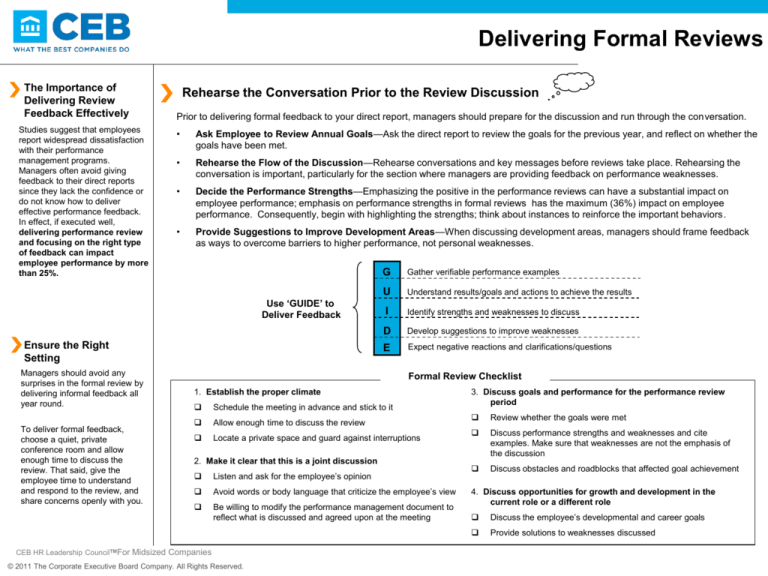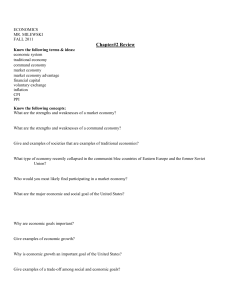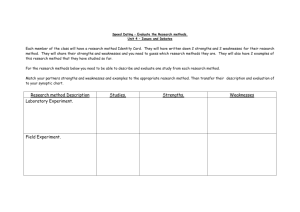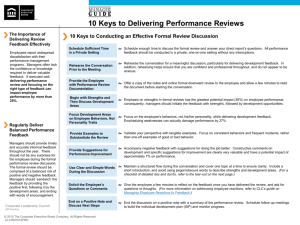
Delivering Formal Reviews
The Importance of
Delivering Review
Feedback Effectively
Studies suggest that employees
report widespread dissatisfaction
with their performance
management programs.
Managers often avoid giving
feedback to their direct reports
since they lack the confidence or
do not know how to deliver
effective performance feedback.
In effect, if executed well,
delivering performance review
and focusing on the right type
of feedback can impact
employee performance by more
than 25%.
Rehearse the Conversation Prior to the Review Discussion
Prior to delivering formal feedback to your direct report, managers should prepare for the discussion and run through the conversation.
•
Ask Employee to Review Annual Goals—Ask the direct report to review the goals for the previous year, and reflect on whether the
goals have been met.
•
Rehearse the Flow of the Discussion—Rehearse conversations and key messages before reviews take place. Rehearsing the
conversation is important, particularly for the section where managers are providing feedback on performance weaknesses.
•
Decide the Performance Strengths—Emphasizing the positive in the performance reviews can have a substantial impact on
employee performance; emphasis on performance strengths in formal reviews has the maximum (36%) impact on employee
performance. Consequently, begin with highlighting the strengths; think about instances to reinforce the important behaviors.
•
Provide Suggestions to Improve Development Areas—When discussing development areas, managers should frame feedback
as ways to overcome barriers to higher performance, not personal weaknesses.
Use ‘GUIDE’ to
Deliver Feedback
Ensure the Right
Setting
Managers should avoid any
surprises in the formal review by
delivering informal feedback all
year round.
To deliver formal feedback,
choose a quiet, private
conference room and allow
enough time to discuss the
review. That said, give the
employee time to understand
and respond to the review, and
share concerns openly with you.
G
Gather verifiable performance examples
U
Understand results/goals and actions to achieve the results
I
Identify strengths and weaknesses to discuss
D
Develop suggestions to improve weaknesses
E
Expect negative reactions and clarifications/questions
Formal Review Checklist
1. Establish the proper climate
Schedule the meeting in advance and stick to it
Allow enough time to discuss the review
Locate a private space and guard against interruptions
2. Make it clear that this is a joint discussion
Listen and ask for the employee’s opinion
Avoid words or body language that criticize the employee’s view
Be willing to modify the performance management document to
reflect what is discussed and agreed upon at the meeting
CEB HR Leadership CouncilTMFor Midsized Companies
© 2011 The Corporate Executive Board Company. All Rights Reserved.
3. Discuss goals and performance for the performance review
period
Review whether the goals were met
Discuss performance strengths and weaknesses and cite
examples. Make sure that weaknesses are not the emphasis of
the discussion
Discuss obstacles and roadblocks that affected goal achievement
4. Discuss opportunities for growth and development in the
current role or a different role
Discuss the employee’s developmental and career goals
Provide solutions to weaknesses discussed
Delivering Formal Reviews
Checklist for an Effective Review Discussions
After reviewing the basics of what should be covered in a formal performance feedback meeting, these guidelines will help initiate and guide an effective feedback
conversation.
Dealing with Negative Employee Reactions
Manager Responses
When a manager must deliver bad news or criticism, dignity, and respect for the employee are critical. The employee must be treated
with honesty and integrity. Employees may respond to bad news in different ways; you should listen to the employee express his or her
feelings of hurt or disappointment and provide pertinent information in response. Examples of employee reactions and the most
appropriate manager responses are indicated below:
Employee Response #1: Anger
• Acknowledge the employee’s reaction
• Allow employee to vent feelings
• Do not get defensive or argumentative
• Remain calm
Employee Response #2: Denial
Employee Response #3: Shock
• Listen actively to make sure the employee • Allow employee time to internalize message
understands message
• Suggest possible next steps
• Repeat or restate comments if necessary
• Use silence and open-ended questions to
prompt employee response
When providing feedback
on employee weaknesses,
avoid judgmental words
such as “poor performance”
or “weakness”; present
these as “development
opportunities”.
Focus on Strengths to Deliver Impactful Feedback
Managers must focus on delivering feedback in such a way that employees gain useful information that will improve their performance in the future. Feedback
can be enhanced by following these suggestions:
Focus on positive accomplishments (performance and personality
strengths), not failures or mistakes
Avoid judgmental comments
Balance criticism with positive feedback (2 positives for each negative)
Be objective, not subjective
Focus on performance, not personal characteristics
CEB HR Leadership CouncilTMFor Midsized Companies
© 2011 The Corporate Executive Board Company. All Rights Reserved.
Keep a positive attitude
Listen to employee’s reaction and comments
Offer solutions to problems
Pinpoint specific examples






